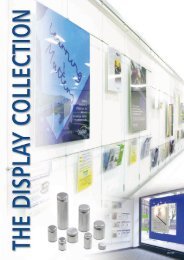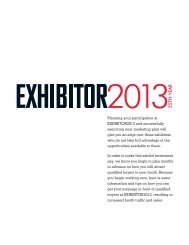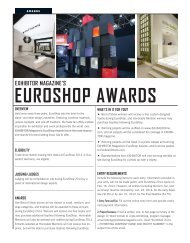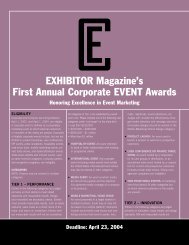Get your FREE PDF article here! - Exhibitor Magazine
Get your FREE PDF article here! - Exhibitor Magazine
Get your FREE PDF article here! - Exhibitor Magazine
- No tags were found...
Create successful ePaper yourself
Turn your PDF publications into a flip-book with our unique Google optimized e-Paper software.
Low DownOn LayoutsEverything you need to know about the six most common exhibit floorplans.By Linda ArmstrongDid you know that a classic diamond style booth layoutis great for a multi-division company, but notoriouslydifficult to staff? Did you know that severaloversized products clutter a random display type of booth,but they’re perfectly at home in a plaza-style layout? Wereyou aware that closed, or club-style exhibits are an awesomecanvas for graphics, but some visitors view them as traps?If you’re like most exhibitors, you probably don’t havea clue. In fact, “t<strong>here</strong>’s a lot of default design and purchasing,”says Tom Bowman, principal of the Bowman DesignGroup of Signal Hill, CA. “If the exhibit house doesn’t showexhibitors the pros and cons of each basic layout, exhibitorsoften think, ‘Hmm... This looks nice, and it seems to fit myneeds. And since I’m not sure what could be wrong or whatmight work better, then, why not? I’ll buy it.’”Sure, some exhibit houses go the extra mile to explain<strong>your</strong> options. But frankly, educating clients isn’t their job.You simply must walk in their doors with a basic understandingof <strong>your</strong> options and a general sense of what willwork best for you.To provide the basics, then, three industry experts haveidentified six core booth layouts and provided some generalguidelines for each. The trio includes Bowman, who providedthe original diagrams, along with Jeremy Regenbogen, principalof San Francisco’s Dual Office (and a 2003 ExhibitDesign Awards judge), and David Albarian, project managerfor Expomobilia, a Swiss firm (with offices in San Diego)specializing in European design. Although our team agreeson the six basic layouts, they caution that variables existwithin each. You can, and should, change each layout’scomponents (theaters, kiosks, monitors, exhibitry), size(both for the booth and components), and positioning(objects rotated at an angle, moved off center, etc.). Butthese core concepts are blueprints for almost all exhibitdesigns, including inlines and peninsulas.Our trio also cautions that t<strong>here</strong>’s no one specific layoutthat’s right for every exhibitor every time. You must mix andmatch layouts and elements to suit each situation. And,what might be a positive for one exhibitor can be a negativefor another. For example, the exclusivity of a closed exhibitcan make those inside feel special and those outside feelrejected. The layout’s impact on <strong>your</strong> program depends onthe location and personality of <strong>your</strong> target audience.Under all the variables, however, are these six core layouts.Our experts have made several generalizations abouteach to provide a sort of “least you should know” guide.Understanding these basics will help you make a confident,informed buying decision the next time around. EBy Linda Armstrong. Questions or comments?E-mail editorial@exhibitormagazine.com.COPYRIGHT EXHIBITOR MAGAZINEEXHIBITOR REPRINT— 3 OF 3 10 —
















